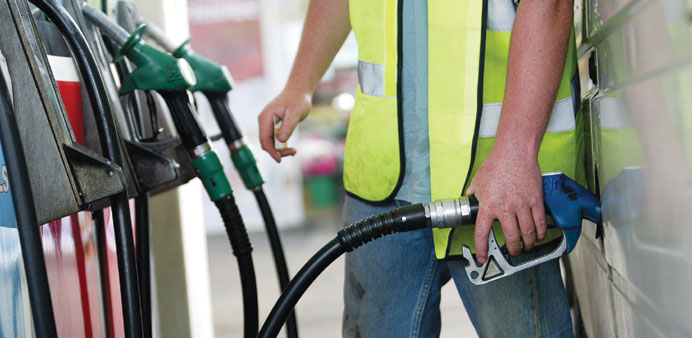A motorist fills up with fuel at a petrol station in London. Global consumption is expected to average 95.7mn barrels a day next year, down 100,000 from estimates in last month’s IEA report.
AFP
Paris
The world’s demand for oil is expected to slow in 2016 in response to a more pessimistic outlook for the global economy, likely keeping the crude market oversupplied, the International Energy Agency (IEA) said yesterday.
“Global demand growth is expected to slow from its five-year high of 1.8mn barrels per day in 2015, to 1.2mn bd in 2016,” moving closer toward its long-term trend, the IEA said in its monthly oil market report.
That will probably mean a continued oil supply glut next year, especially with the expected arrival of Iranian crude.
“A projected marked slowdown in demand growth next year and the anticipated arrival of additional Iranian barrels — should international sanctions be eased — are likely to keep the market oversupplied through 2016,” it said.
Citing the International Monetary Fund’s recent downward revisions on global growth estimates by one-fifth of a percentage point, “projections for commodities demand logically require some trimming,” the report said.
Global consumption is expected to average 95.7mn barrels a day next year, down 100,000 from estimates in last month’s report.
One surprise is the resilient oil demand in China despite its economic slowdown.
“Our preliminary August estimate posted a near double-digit percentage point gain in year-on-year terms despite the otherwise ailing macroeconomic backdrop,” the Paris-based agency said.
Crude oil prices were relatively stable in September and have rallied early this month on “expectations of a lower US output and rising tension in the Middle East,” the IEA said.
European benchmark Brent oil for November delivery rose 55 cents to $50.41 a barrel in London yesterday.
US benchmark West Texas Intermediate for November delivery was up 69¢ to $47.79 a barrel on the New York Mercantile Exchange.
The IEA, a Paris-based institution which analyses energy markets for advanced oil-consuming nations, noted that oil prices over $50 per barrel were “a powerful driver in rebalancing the global oil market, but the big question is just when will the equilibrium be restored.”
Russia’s military intervention in Syria has raised international political tensions and created uncertainty — although for now the global oil supply glut is tempering market reaction.
“Some of this uncertainly may start to clear next year although, considering Iran, the market may be off balance for a while longer,” the report said.
Crude output by the 12-nation Opec rose by 90,000 barrels a day to 31.72mn in September driven by Iraq, now the world’s biggest source of additional supply.
Iraq’s banner month to a record 4.3mn barrels per day was due to a recovery in northern exports from disruptions along the country’s pipeline to Turkey. “But severe budgetary strain and ongoing issues with security and infrastructure are likely to limit supply growth in the near-term for Iraq,” the IEA added.
As for non-Opec producers, supply growth is eroding with the sharpest slowdown in the US. In September non-Opec oil production is estimated to have dropped by 180,000 barrels per day to 58.3mn.
In 2016 lower oil prices and steep spending cuts are expected to reduce non-Opec output by nearly 500,000 barrels per day, the report added.



